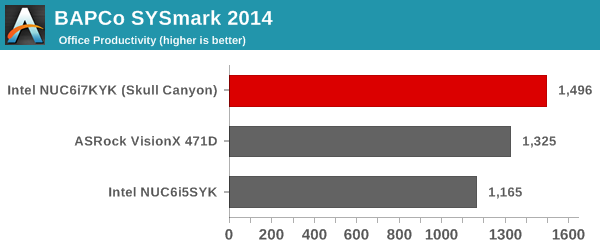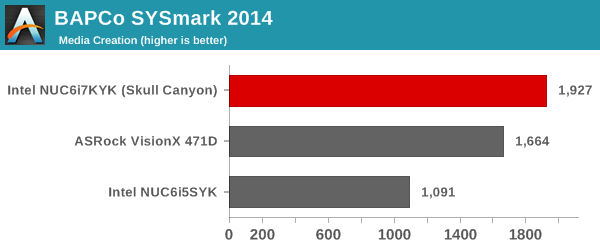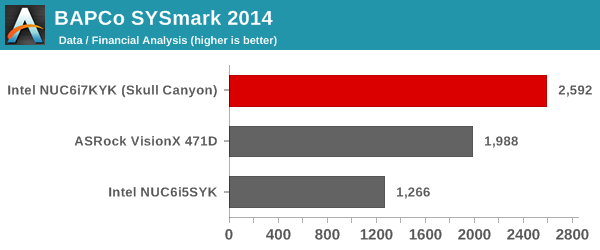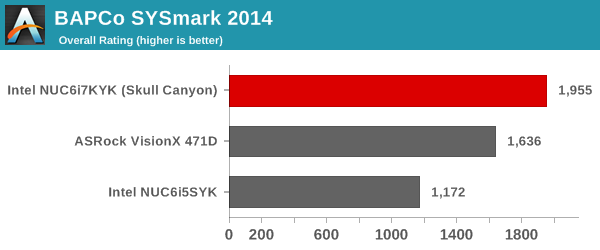The Intel Skull Canyon NUC6i7KYK mini-PC Review
by Ganesh T S on May 23, 2016 8:00 AM ESTPerformance Metrics - I
The Intel NUC6i7KYK (Skull Canyon) was evaluated using our standard test suite for low power desktops / industrial PCs. Not all benchmarks were processed on all the machines due to updates in our testing procedures. Therefore, the list of PCs in each graph might not be the same. In the first section, we will be looking at SYSmark 2014, as well as some of the Futuremark benchmarks.
BAPCo SYSmark 2014
BAPCo's SYSmark 2014 is an application-based benchmark that uses real-world applications to replay usage patterns of business users in the areas of office productivity, media creation and data/financial analysis. Scores are meant to be compared against a reference desktop (HP ProDesk 600 G1 with a Core i3-4130, 4GB RAM and a 500GB hard drive) that scores 1000 in each of the scenarios. A score of, say, 2000, would imply that the system under test is twice as fast as the reference system.




We started using SYSmark 2014 quite recently, which is the main reason for the absence of many of the comparison systems in the above graphs. In any case, the most interesting of the compared lot when it comes to CPU-intensive benchmarks like SYSmark 2014 is the ASRock VisionX 471D, equipped with a Core i7-4712MQ processor. We can see that the Core i7-6770HQ-based Skull Canyon NUC6i7KYK is miles ahead of the other two systems when it comes to office / business workloads. Readers interested in comparing the SYSmark 2014 scores for systems based on other CPUs can peruse the Bench results here.
Futuremark PCMark 8
PCMark 8 provides various usage scenarios (home, creative and work) and offers ways to benchmark both baseline (CPU-only) as well as OpenCL accelerated (CPU + GPU) performance. We benchmarked select PCs for the OpenCL accelerated performance in all three usage scenarios. These scores are heavily influenced by the CPU in the system. As expected, the Core i7-6770HQ enables the NUC6i7KYK to easily come out on top in the charts.



Miscellaneous Futuremark Benchmarks

The graphics benchmarks present a different story, though. In these, the NUC6i7KYK does perform well enough to come in the top half. However, in scenarios which are not CPU-bound, the systems equipped with discrete GPUs easily turn out to be better than Skull Canyon.




3D Rendering - CINEBENCH R15
CINEBENCH R15 is a standard benchmark for 3D rendering. It provides three benchmark modes - OpenGL, single threaded and multi-threaded. Evaluation of select PCs in all three modes provided us the following results.



In the single-threaded case, the Core i7-4770R (a 65W TDP CPU which can turbo up to 3.9 GHz) performs slightly better than the Core i7-6770HQ. However, the latter wins out in the multi-threaded cases. In the OpenGL case, the GIGABYTE system with the discrete GPU wins out, showing that a combination of CPU power as well as GPU is needed to perform well in this benchmark.










133 Comments
View All Comments
jasonelmore - Monday, May 23, 2016 - link
it will work fine. Intel has been using the Razer External GPU Chassis and they even commented on it here on Anandtech Comments, on the last article that was posted about it. DMI 3.0 still does 4GB/s and the CPU is not transferring huge amounts of bandwidth hungry texture data back and forth with the CPUlmcd - Monday, May 23, 2016 - link
Plus the fact that PCIe 2.0 x4 was shown to be the tipping point between bandwidth limited and not for single GPU systems, I believe. 3.0 is twice that, and 2.0 4x barely even throttled that one graphics card -> there's a decent bit of overhead available.Cuhulin - Wednesday, May 25, 2016 - link
The only question I have about the Razer Core approach is price. Wouldn't it be better to simply buy a Razer Stealth instead?fanofanand - Monday, May 23, 2016 - link
Grandpa/Grandma don't need a 1k PC. They would be adequately served by the PC sticks. This would be massive overkill for Fakebook browsing. This is a product desperately searching for a niche market.gurok - Monday, May 23, 2016 - link
You say that, but they've incorporated a skull design specifically for grandpas/grandmas.Cuhulin - Wednesday, May 25, 2016 - link
Let's see whether you think the same way when you are a grandparent, or at least old enough to be one. I am a grandfather, and I need a decent PC for my 4k gaming, among other things - which means way more than 1k at this time. (I have at least 2k in the 3 4k monitors on my desk, for one thing). I suck at FPS games these days - reflexes just aren't what they were decades ago - but I still have fun. So maybe the ageism should be put away?Calista - Monday, May 23, 2016 - link
Why would you spend 1000 dollars on something a 300 dollar machine does almost just as well? No, this is a really an odd product which can't be upgraded, which can't play current games and which cost an arm and a leg. And why, to save a little bit of space on a desk already housing a (most likely) large monitor, large keyboard and a mouse. I could see the charm of something like this had we had easy access to MXM (or similar standard) modules. But for anyone else far better and almost as small options seem to exist.milkod2001 - Tuesday, May 24, 2016 - link
for $1000 one can get same specs laptop which comes with screen and keyboard already = much better buy/value.The only thing when NUCs make sense is if you need to hook it behind telly and use it as streaming device otherwise any other option gives you much more.
Calista - Tuesday, May 24, 2016 - link
Yeah. I have never understood this "I need a high-end PC, thus I buy an expensive PC which will only be high-end for the next 12 months" while keeping it for the next three years. Either we need high-end components and then we will always need the latest high-end components or else we don't need high-end components and then it doesn't make sense to buy expensive bleeding edge stuff.JBSZQn1LI06L8j33 - Tuesday, May 24, 2016 - link
i am thinking about it, but it is too expensive right now. it needs to be $400 and should come with windows usb. Right now it is basically laptop without keyboard, screen, touch-pad and external power supply. I really like the form factor ...